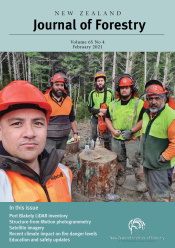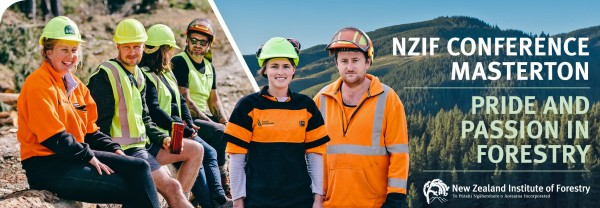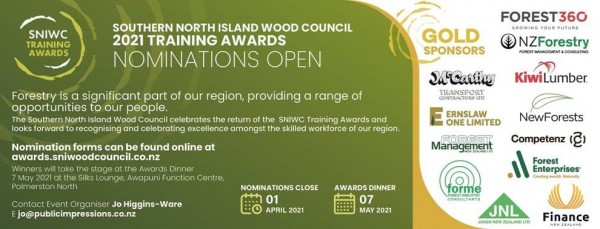22nd March 2021 Newsletter
PRESIDENTS COLUMN

I want to thank all of you who responded to my last column asking for help and thoughts around native forest planting. Many of you have agreed to have your comments added to the members voice and I encourage all members to read these and make further comments. A robust, polite debate is what we need if we are going to offer any guidance to this Government and officials. I am 100% positive our members are best place to offer this guidance and as such we need to hear from you.
One suggestion made is we set up a Special Interest Group called “Native Forests” under rule 187, which states ‘At the request of at least five members, the Council may establish or approve the establishment of a Special Interest Group for Members who have a community of interest in a professional, technical or other aspect of forestry. The Council shall appoint a Member to be the convenor of the group.’ If anyone is interested in setting up a Special Interest Group along the theme of native forests, please let me (President@nzif.org.nz) or Raewyn (Admin@nzif.org.nz) know and we will set up if we have 5 members or more.
On the topic of Special Interest Groups (SIG) we currently have two SIG’s. They are the Future Foresters and Women in Forestry. Future Foresters is going gang busters, however the Women in Forestry SIG needs some attention. If any member is interested in reinvigorating this SIG again please let Raewyn or myself know.
The council has also established five Committees / working parties (under rule 94). These Committees are Valuations, Fire, Fellows, Ethics, Forest Advisors. Some like the Valuations and Fellows have been around for many years, others like the Fire and Forest Advisors are relatively recent. However all committees have been formed to help inform and advise the council and in many instances to recommend standards, procedures and policy. Again if you you would like to be involved in any of these committees please let Raewyn or I know.
You may ask why we have so many SIG’s and Committees and the answer is very straightforward. Council is currently made up of people who also hold another, paying, role. Members of the council simply do not have the time to undertake all the work required to ensure NZIF is the most successful it can be in delivering its Objects (rule 6). Having Committees and SIG’s helps us do this. In other words council needs your help to make NZIF flourish and provide for the need of members.
NZIF is a member organisation; as such it does ask for input from all members to help it achieve its Objects. We set expectations on all members to ensure we can advance the profession of forestry within New Zealand and one of those unwritten expectations on all members is they take an interest in their Institute and get involved where they can to help advance the profession for all members. As such I make a plea to all members to consider what input (outside of fees) you are putting in to help grow professionalism within forestry. There are many ways you can help including but not limited to; involvement with your local section, joining a SIG (or forming a new one), becoming part of a committee, getting involved with the conference committee if in your area, working to become registered, starting or entering debate on topics within the newsletter, volunteering to help with NZIF submissions (currently working on the Climate Change Commission submission), putting your name forward for election for Council, Fellows Committee (if a Fellow) or the Registration Board, writing an article for the Journal …..
Finally, one more way you could help is by supporting your Foundation. The Foundation was formed in 2011 with the goal to advance education in relation to forestry. Forestry has a very wide definition and includes forest for all uses, wood processing, and any forest related activity. The goal of advancing education is to ensure we are all continually learning and developing and as such advancing the profession of forestry which is NZIF’s goal. As such I would encourage all members to make an annual donation to the Foundation. It is a charity so your donation is tax free. I am well aware the Trustees would like to offer more and higher Scholarship and awards than they currently do, but to do so the fund needs to be built up by at least $500,000. To keep the current scholarships the Foundation needs a minimum income of $7000-$10,000 per annum (this will not allow for any award growth). We have approximately 700 members (not including students). Therefore if every member made a $10 donation the Foundation will be able to continue with its awards. If we all gave a bit more, then the Foundation can start growing the awards for the benefit of all members. I encourage you all to make a donation today; Donations can be made through internet banking to BNZ 02 1269 0014573 00. Please include or name in the details fields and email to advise you have made a donation and whether or not you require a receipt for tax purposes.
As always, I would love to hear from you with ideas and thoughts on what we can do better, and what we are doing well and should continue. Feel free to add them into members voice or email me directly. We have a fantastic profession with amazing people, it is my very real hope by the end of my term we all feel the profession of forestry is being heard, respected and it is advancing and growing.
Thanks
James
MEMBERS VOICE
The feeling that there is a decline
The feeling that there is a decline in rural New Zealand that originates from the sunset pastural farming sector struggling with declining product demand. Forest industry has a completely different perspective, where the reality is increases in plantation development, expanding wood production and growth of sales of wood to national and international markets and increasing employment. Unfortunately, the urban majority population largely only sees the perspective of the agriculture sector.
Land use change in New Zealand is a nuanced issue. During the first part of the century, agricultural land was dominated by sheep pastural farming. Today, land use has transitioned significantly with establishment of horticulture and dairy farming on the most productive land, and pastural farming and plantation farming competing for the remaining lands. Plantation forestry and native forestry is now competing for the least productive and weed prone areas.
Plantation forestry is out-competing pastural farming in many cases, principally because the returns on investment are significantly superior. The expansion of income streams using carbon crediting has further increased forestry competitiveness based on the environmental superiority of plantation forestry over pastural farming from a emissions reduction perspective.
Forestry generates significantly more FTE jobs per 1000 hectares, both on land, and from downstream processing, as documented in “A Comparison of the Employment Generated, Forestry and Agriculture in New Zealand: Fairweather, Mayell and Swaffield (2020), Research Report No. 246. Agribusiness and Economics Research Unit, Lincoln University.
The reported population decline is largely a fallacy. Rural populations in New Zealand are increasing according to the Statistics New Zealand in all regions of New Zealand except the Buller region. There is continual and on-going business and job growth in the dairy, horticulture and forestry sectors but the pastural sector is largely in decline from an employment perspective.
I don’t want this to come across as an exercise of triumphalism, but the reality is that sheep farming in particular is in decline and land use change to alternative land uses is inevitable. The sooner policy makers and the general population understand that, the sooner the needs for changes to infrastructure, Government services and sector planning can be identified and addressed.
GEORGE KURU
____________________________________________________________________________________________
The President is asking for help
The President is asking for help in dealing with media questions on indigenous forests. Of course we should know the answers, but since the Government stopped the industry from managing indigenous forests back in 1987, and then withdrew any incentives to plant them until 3 years ago, the 30-year gap means that most of us have very little depth of experience in this area. Back in the 1990s I spoke to Peter Berg about whether the NZ Forest Service records of kauri and beech forest establishment and management were available in the National Archives where I was searching for other files; my feeling was they were. Peter duly searched and recovered what he could as foundation material for Tane’s Tree Trust, and as far as I know, that’s where most of the knowledge and experience now sits.
As for the ‘environmental disaster’ of planting new forests on farmland, I’m not sure where else anyone expects them to go. If we need trees (and all the reports say we do) we have to plant them on land where they will thrive; and if the landowner wants to earn carbon credits to help offset the cost of planting and loss of income from changing land use, the trees have to be planted on eligible land (grassland). That’s the blunt logic and the Mayor of Waitaki knows it. He also knows that the problem is basically a political one where he who screams loudest gets the best result. (The classic “Why me?” problem. “Why am I paying the cost? Why not that jerk Jones, or that bum Brown?”)
Since the alternative to planting forests is to cut emissions heavily at source, his “Why me?” call is a challenge to the major emitters like concrete, steel and transport. If they cut emissions, he won’t need trees. He’s not challenging us. We might deplore his science, but we’re not involved. Let’s sit back and see who wins.
Howard Moore
____________________________________________________________________________________________
In response to James' call for ideas.
1; Stop farmers destroying regenerating native forest, native grass and shrublands.
The clearance of regenerating native forest on the 9000 ha Te Anau Downs property that straddles the most important tourist route in the country is an egregious example.
Step 2: Establish as much pine as possible. In my experience for every 5 ha of pine there is an associated 1 ha of native bush that receives de facto protection compared to farming.
Pines provide an excellent nurse crop for native forests for many reasons, one being that they suppress exotic grasses, which are the bitter enemy of native forest species in both a literal and figurative sense.
Step 3; Counter the anti exotic conifer rhetoric pushed by the likes of ex Minister of Conservation Eugenie Sage and the misguided Dame Anne Salmon.
Step 4; Counter the anti forestry rhetoric and lies from the farming sector such as the drivel put out by Wairoa Mayor, Craig Little.
Step 5; Sell the idea the forestry is important for carbon sequestration, maintenance of water quality, improvement and protection of soil, harbouring native diversity and then beyond the forest wood is important for the materials we need to substitute for fossil fuel intensive products such as iron, aluminium, cement, fuel and petrochemicals.
Step 6; Farmers need to be educated that they need to plant at least 10% of their land in trees to mitigate their emissions. The best land to plant is the 20-30 metres each side of waterways. This number is based on science which says that this the amount of ungrazed buffer needed to prevent silt, nutrients and faecal coliforms from entering waterways.
Farmers need to know if they do not plant the 10% someone else will do it in their stead.
Regards
Owen Springford
____________________________________________________________________________________________
My view of what it’s worth
My view of what it’s worth is that NZIF should tel the CCC and whoever else is willing to listen that planting 300k ha in natives is a hopelessly unattainable target.
Furthermore, given that NZ relies on the exports of products from the land particularly food and timber and logs for its economic survival, planting 300k of natives is a gross mis-use of land even if it was possible.
Furthermore the CCC should be reminded that under the Paris Accord mitigation of climate change policies by countries article 2(b) states “increasing the ability to adapt to the adverse impacts of climate change and foster climate resilience and low greenhouse gas emissions development, in a manner that does not threaten food production”.
It should also be pointed out to the CCC that humans don’t wish to resort to living in caves or shelters from palm fronds where the opportunity exists for land to be planted in commercial species used to build houses.
Furthermore it should be pointed out that the media and environmental groups and politicians are only too keen to state that NZ has high GHG emissions per head of population at around 18 tonnes per capita. However, that figure is mis-leading as New Zealand is a major food producer and nutritionally produces annually enough food to feed 70 million people. On that basis NZ GHG emissions are only 1.15 tonnes per head of people fed from NZ’s food production.
So if 300,000ha of land is to be converted to native plantings it must have a significant impact on food production because that area of land would have to come largely from land currently producing food.
Kind regards
David Buckleigh
____________________________________________________________________________________________
Amongst several comments
Amongst several comments I made to the Climate Change Commission’s draft report was that their report should
“Provide a provocative forecast of what might happen to Aotearoan agriculture and greenhouse gas production should “clean-” meat and dairy products be produced worldwide in quantity, substantially cheaper than that produced from animals, soon.”
It is very startling how quickly change can occur. Peter Casey on page 10 of his paper in the February 2019 issue of NZJF, showed two photographs of the New York Easter Parade. The first in 1900, showed one automobile amongst the many horse drawn carriages. The second in 1913 at the same vantage point, showed one horse drawn carriage amongst the many automobiles. I doubt any breeder of horses or carriage maker would have dreamed what was going to happen to their business in such a short time.
The New Zealand public today are unlikely to accept that the 25,000 ha / year of new production forest proposed by the CCC be established in large forest blocks such as Kaingaroa or even smaller forests such as Mohaka. However, there is ample opportunity for small-scale forest owners, planting smaller blocks on parts of their land that cost more than they gain from agriculture. To do this effectively and consistently, professional Forest Management Organisations need to evolve, representing these owners at all levels from government to negotiating with or organising contractors, as in many other countries. For example, in Sweden Södra has 53,000 small-scale forest owners, owns several wood processing facilities, with a profit of NZ$146 million and a distribution of NZ$98 million (2020). To transform to such a professional Forest Management Organisation has not been achieved without government assistance. It should be a key component of Te Uru Rākau objectives.
Chris Goulding, retired.
Come ride on our model trains, Hamilton Model Engineers
Sundays, bring your kids if you need an excuse.
INSTITUTE UPDATE
The impact of recent climate on fire danger levels in New Zealand
Have changes in weather conditions impacted on the day-to-day management of fires in the New Zealand forest and rural landscape? Read more
A Fire Danger Assessment for New Zealand - overview graphs Tables
____________________________________________________________________________________________
Registration Board member

Ellanese is a Registered Member of the NZIF and has been co-opted to the Registration Board for a period of 1 year. She holds a Bachelor of Forestry Science degree from the University of Canterbury (2000) and a Postgraduate Diploma in Business from the University of Auckland (2017). Ellanese has worked in the New Zealand Forest industry in technical, forest management and consulting roles and hopes to bring to the Board the perspective of a mid-career practicing registered consultant.
____________________________________________________________________________________________
JOURNAL OF FORESTRY
Latest Journal of Forestry is now on the Website read more

____________________________________________________________________________________________
Nominations for the 'Forester of the Year' and
'The Prince of Wales Award for Sustainable Forestry'
Please return your nominations by the 30th April 2021
Forester of the year Nominate here
The Prince of Wales award for Sustainable Forestry Nominate here
FORESTRY EVENTS
The NZ Farm Forestry Association invites NZIF members
The NZ Farm Forestry Association invites NZIF members to a presentation on the evening of Wednesday 24 March
“Rottenomics, The Story of New Zealand’s Leaky Building Disaster” published
in 2019.
Peter Dyer will speak on the requirements to fix what is a structural failure
in the New Zealand Building Code.
“Use of wood in design of the Nelson Airport Terminal and the Sir Robert
Jones Building refurbishment, Wellington.”
Marc Woodbury, Senior Partner, Studio Pacific Architecture
Place: the Loft bar, Black&Gold, level 2 Harbourside (where Taranaki St meets the wharf).
Time: 7 pm. Drinks and nibbles available.
RSVP: please respond so we know the numbers, to: admin@nzffa.org.nz
This function is part of the NZ Farm Forestry Association annual conference made possible
by the following sponsors: Read more
____________________________________________________________________________________________
Overseas Investment Office Presentation
Save the date........
Wednesday 21 April 2021, Hawkes Bay
Venue: East Pier, Ahuriri, Napier
Time: 5.30pm
Members of the Overseas Investment Office will provide an update on the overseas investment regime and how it relates to investment in forestry.
Sponsorship: Venue hire, sponsored by - FMNZ Ltd, Refreshments prior to meeting sponsored by - Colliers HB
____________________________________________________________________________________________
NZIF 2021 Conference

27th to 29th June 2021
Copthorne Hotel & Resort Solway Park
High Street
Masterton
We are excited to be presenting a varied and inspiring lineup for our next conference to be held in Masterton in the mighty Wairarapa. We all know how passionate our sector work force is about what we do, and we are seeking to showcase some of this pride with our lineup of speakers and CPD sessions.
IN THE NEWS
Calling for Nominations SNIWC Training Awards 2021

____________________________________________________________________________________________
Royal Society Te Apārangi - New Fellows announced
I’m pleased to let you know that the Society has today released an announcement about the election of the latest Ngā Ahurei a Te Apārangi Fellows and Ngā Ahurei Honore a Te Apārangi Honorary Fellows into the Academy of Royal Society Te Apārangi. Details of the announcement can be found here: https://www.royalsociety.org.nz/news/researchers-and-scholars-elected-to-academy/
Twenty-seven new Fellows have been elected to the Academy for their distinction in research and advancement of science, technology or the humanities. They are exceptional leaders in their communities and their areas of research and scholarship.
Being made a Fellow is an honour that recognises distinction in research, scholarship or the advancement of knowledge at the highest international standards. Fellows can use the post-nominal ‘FRSNZ’ after their name to indicate this honour.
Chair of the Academy Executive Committee Professor Charlotte Macdonald FRSNZ says it was pleasing to see a large cohort of Fellows elected this year, all with such exceptional expertise.
“The newly-elected Fellows have made amazing contributions to knowledge in their fields and across disciplinary boundaries. Their election adds significantly to the breadth of knowledge held within the Academy; they will help support the purpose of Te Apārangi to engage with and inform New Zealanders on topics important to all.”
“On behalf of the Academy and Society, I heartily congratulate all the new Fellows. The election process is rigorous and new Fellows can be rightfully proud that their outstanding achievements have been recognised by their peers in this way.”
The new Fellows will be formally inducted at an event in Whanganui-a-Tara Wellington on 29 April.The new Fellows are:
- Professor Doug Armstrong, Massey University
- Professor Helen Moewaka Barnes, Massey University
- Professor Deidre Brown, University of Auckland
- Professor Charles Eason, Lincoln University
- Dr Susan Gardiner, Plant & Food Research
- Distinguished Professor Neil Gemmell, University of Otago
- Professor Gail Gillon, University of Canterbury
- Professor Jarrod Haar, Auckland University of Technology
- Garth Harmsworth, Manaaki Whenua - Landcare Research
- Professor Rawinia Higgins, Victoria University of Wellington –Te Herenga Waka
- Professor Andrew Hill, University of Auckland, Middlemore Hospital
- Professor Patria Hume, Auckland University of Technology
- Professor Robert Jahnke, Massey University
- Professor Robin Kearns, University of Auckland
- Dr Rangi Matamua
- Professor Janet McLean, University of Auckland
- Professor Julian Paton, University of Auckland
- Professor Steven Ratuva, University of Canterbury
- Professor Poia Rewi, University of Otago
- Associate Professor Damon Salesa, University of Auckland
- Professor Caroline Saunders, Lincoln University
- Distinguished Professor Graham Hingangaroa Smith, Massey University
- Professor Michelle Thompson-Fawcett, University of Otago
- Professor Denise Wilson, Auckland University of Technology
- Professor Zhi-Qiang Zhang, Manaaki Whenua - Landcare Research
The Society also announced the election of two Ngā Ahurei Honore a Te Apārangi Honorary Fellows. The election of Honorary Fellows aims to encourage strong ties with leading international scientists and scholars and New Zealand’s research community.
The new Honorary Fellows are:
- Professor Penelope Brothers, Australian National University, Australia
- Distinguished Professor Ravendra (Ravi) Naidu, University of Newcastle, Australia
Ngā mihi
Marc
Dr Marc Rands
Academy Executive Officer
Royal Society
____________________________________________________________________________________________
Royal Society news
Royal Society Te Apārangi | Issue #1130
NZIF Administrator
Email: NZIF Office
Mobile: +64 22 653 3750
NZIF Registration Board
Email: Registrations
Mobile: +64 27 463 1118
Complaints
Email: Complaints
Appeals
Email: Appeals
© All rights reserved. No part of this site may be reproduced, adapted, or distributed without prior written permission
We are a forum to exchange ideas, opinions and information about forestry.
We encourage and help our members attain and maintain the highest standards of their profession.




